Abstract
Web Science and Human-Computer Interaction (HCI) are interdisciplinary arenas concerned with the intersection of people and technology. After introducing the two disciplines we discuss overlaps and notable differences between them, covering subject matter, scope and methodology. Given the longer history of HCI, we identify and discuss some potential lessons that the Web Science community may be able to take from this field. These concern: the division between interpretivist and positivist approaches; methods and methodology; evaluation; and design focus and methods. In summary, this paper clarifies the relationship between the communities, signposting complementary aspects and ways in which they might collaborate in future.
Keywords: spreading activation, reasoning, linked open data, context
References
- Apple Computer Inc. (1987). Macintosh Human Interface Guidelines, first edition. Addison-Wesley.
- Bannon, L. 2011. Reimagining HCI: toward a more human-centered perspective. Interactions 18, 4 (July 2011), 50-57. DOI=10.1145/1978822.1978833
- Bazan S., Varin, C., Saad, S. (2011) Sharing innovative teaching experience in higher education on the Web. An interdisciplinary study on a contextualized Web 2.0 application for community building and teacher training. pp. 1-7. In: Proceedings of the ACM WebSci'11, June 14- 17 2011, Koblenz, Germany.
- BELIV: BEyond time and errors: novel evaLuation methods for Information Visualization. Accessed 7/2/2012. http://www.beliv.org/
- Berners-Lee, T., Hall, W., Hendler, J. A., O'Hara, K., Shadbolt, N. and Weitzner, D. J. 2006. A Framework for Web Science. Foundations and Trends in Web Science, 1(1), 1:130.
- Berners-Lee, T., Hall, W., Hendler, J., Shadbolt, N. and Weitzner, D. J. 2006. Creating a Science of the Web. Science, 313 (5788), 769 - 771.
- Blandford, A. and Sutcliffe, A. (eds) (2010). Special Issue: Festschrift for John Long. Interacting with Computers 22, 1 (January 2010), 1-74.
- Coyle, D., Linehan, C., Tang, K.P., & Lindley, S., (2012) Interaction Design and Emotional Wellbeing. In proc ACM CHI 2012 Extended Abstracts.
- Dix, A. (1997). Challenges for Cooperative Work on the Web: An analytical approach. Computer-Supported Cooperative Work: The Journal of Collaborative Computing 6, pp. 135-156.
- Dix, A., Finlay, J., Abowd, G. Beale, R. (2004). Human–Computer Interaction (3rd edition). Prentice Hall. http://www.hcibook.com/e3/
- Dix, A. (2010). Human–computer interaction: A stable discipline, a nascent science, and the growth of the long tail. Interacting with Computers 22 (2010) 13–27
- Economides, N. (1996) The Economics of Networks. Intnl. Jnl of Industrial Org. Oct. 1996
- D. C. Engelbart. A conceptual framework for the augmentation of man's intellect. In P. W. Howerton and D. C. Weeks, editors, Vistas in Information Handling, volume 1, pages 1–29. Spartan Books, Washington, DC, 1963.
- .J. Grudin. Why CSCW applications fail: Problems in the design and evaluation of organisational interfaces, Proceedings of the Conference on Computer-Supported Cooperative Work (CSCW '88), pp. 85-93, ACM Press, 1988.
- Halpin, H., Clark, A., Wheeler, M. (2010) Towards a Philosophy of the Web: Representation, Enaction, Collective Intelligence. In: Proceedings of WebSci10: Extending the Frontiers of Society On-Line, April 26- 27th, 2010, Raleigh, NC: US.
- Hanson, V.L. Social inclusion through digital engagement. HCI International (Orlando, FL, USA, July 9 - 14, 2011). In Stephanidis, C. (Ed.): Universal Access in HCI, Part I, HCII 2011, LNCS 6765, Springer-Verlag Berlin Heidelberg. pp. 473–477. 2011.
- Hillier, B. (1999). Space is the Machine: A Configurational Theory of Architecture. Cambridge University Press.
- Hooper, C.J., Marie, N., Kalampokis, E. (2012) Dissecting the Butterfly: Representation of Disciplines Publishing at the Web Science Conference Series. Web Science 2012. (In Press)
- Karnstedt, M., Rowe, M., Chan, J., Alani, H., Hayes, C. (2011) The Effect of User Features on Churn in Social Networks. pp. 1-8. In: Proceedings of the ACM WebSci'11, June 14-17 2011, Koblenz, Germany.
- .Keegan, B., Ahmad, M. A., Williams, D., Srivastava, J., & Contractor, N. (2011). Sic Transit Gloria Mundi Virtuali? Promise and Peril at the Intersection of Computational Social Science and Online Clandestine Organizations. In: Proceedings of the ACM WebSci'11, June 14-17 2011, Koblenz, Germany.
- Khan, S. Moore, R., Weal, M.: Social Media on the Job: An exploration of the potential legal consequences of employer's social media usage whilst during the course of employment. In: Proceedings of the ACM WebSci'11, June 14-17 2011, Koblenz, Germany.
- Krotoski, A, Why Study the Web? Social Machines and the Virtual Revolution. Royal Society panel, March 2010 http://Web Science.org/event/48.html
- Liebowitz, S. and Margolis, S. (1998) Network Externalities (Effects). The New Palgraves Dictionary of Economics and the Law, MacMillan, 1998.
- Long, J., Dowell, J., 1989. Conceptions of the discipline of HCI: craft, applied science, and engineering. In: Sutcliffe, A., Macaulay, L. (Eds.), Proceedings of the Fifth Conference of the British Computer Society, Human–Computer Interaction Specialist Group on People and Computers V, Cambridge University Press, New York, pp. 9–32.
- McCabe, C., Watson, R.A., Prichard, J., Hall, W. (2011) The Web as an Adaptive Network: Coevolution of Web Behavior and Web Structure. pp. 1-7. In: Proceedings of the ACM WebSci'11, June 14-17 2011, Koblenz, Germany.
- Metaxas, P, Mustafaraj, E, From Obscurity to Prominence in Minutes: Political Speech and Real-Time Search. In: Proceedings of the ACM WebSci'10, Raleigh, USA.
- Norman, D. and Draper, S. (Eds.) (1986). User Centered System Design: New Perspectives on Human-computer Interaction. Lawrence Erlbaum Associates.
- Reinecke, K., Bernstein, A.. 2011. Improving performance, perceived usability, and aesthetics with culturally adaptive user interfaces. ACM Trans. Comput.- Hum. Interact. 18, 2, Article 8 (July 2011), 29 pages. DOI = 10.1145/1970378.1970382
- Schuler, D. and Namioka, A. (Eds.) (1993) Participatory design: Principles and practices. Lawrence Erlbaum Associates.
- Shackel, B. Ergonomics for a computer, Design 120 (1959) 36–39.
- Shadbolt, N. What Is Web Science? talk, http://Web Scienceence.org/Web Scienceence.html
- Shneiderman, B. 2007. Web Science: A Provocative Invitation to Computer Science. Communications of the ACM, 50 (6), 25-27.
- Shneiderman, B. 2011. Claiming Success, Charting the Future: Micro-HCI and Macro-HCI. Interactions, September + October 2011, 10 - 11.
- Taylor, N., Marshall, J., Blum-Ross, A., Mills, J., Rogers, J., Egglestone, P., Frohlich, D.M., Wright, P., Olivier, P. Viewpoint: Empowering Communities with Situated Voting Devices (2012) Proc. CHI 2012, New York: ACM
- Usability Professionals' Association (2012). What is User-Centered Design? accessed 11th February 2012 http://www.upassoc.org/usability_resources/about_usability/what_is_ucd.html
- Vafopoulos, M.: Modeling the Web Economy: Web Users and Goods. In: Proceedings of the ACM WebSci'11, June 14-17 2011, Koblenz, Germany.
- Vafopoulos, M. Web Science Subject Categorization (WSSC). The Web Science Trust, 2011. http://WebScience.org/2010/wssc.html
- Winograd, T. 1997. The design of interaction. In Beyond calculation, Peter J. Denning and Robert M. Metcalfe (Eds.). Copernicus, New York, NY, USA 149-161.
- Wu, L., Liu, D. (2009) Chinese Citizen's Attitude towards Internet Censorship: a Survey in Mainland China, 2005. In: Proceedings of the WebSci'09: Society On-Line, 18-20 March 2009, Athens, Greece.
- Yip, M (2011) An Investigation into Chinese Cybercrime and the Applicability of Social Network Analysis. pp. 1-4. In: Proceedings of the ACM WebSci'11, June 14-17 2011, Koblenz, Germany.
|
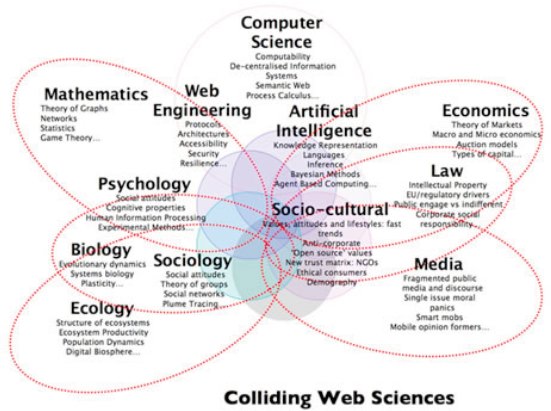
Fig1. The original 'Web Science butterfly' [31].
[zoom image]
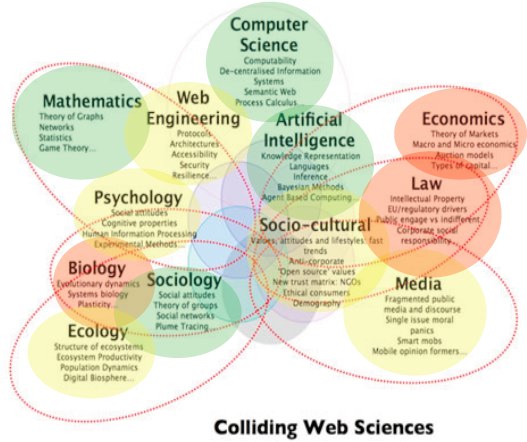
Fig. 2. Web Science 'heat map', showing
discipline presence [18]. Green denotes greater presence, yellow middling presence, red low presence
[zoom image]
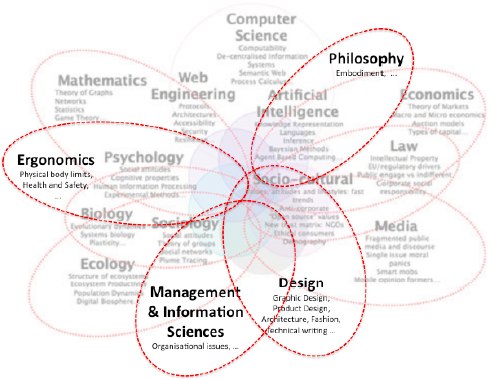
Fig. 3. The 'HCI + Web Science butterfly'
[zoom image]
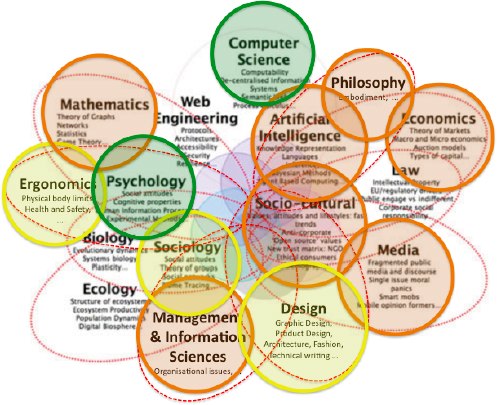
Fig. 4. The HCI heat map
[zoom image]
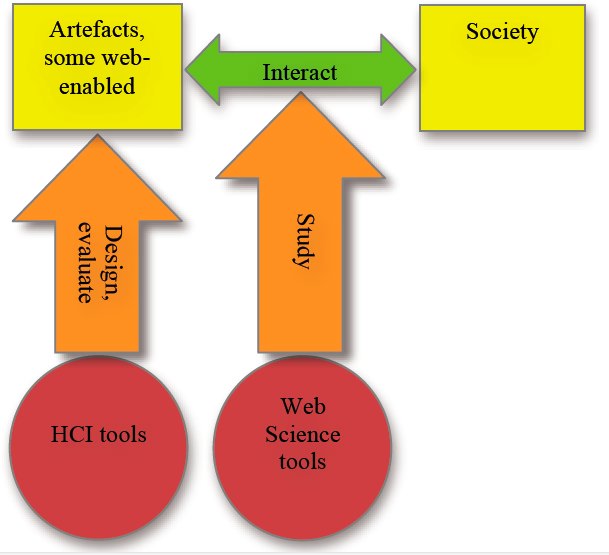
Fig. 5. How HCI and Web Science relate (first
impressions)
[zoom image]

Fig. 6. Scope of HCI and Web Science (first impressions)
[zoom image]
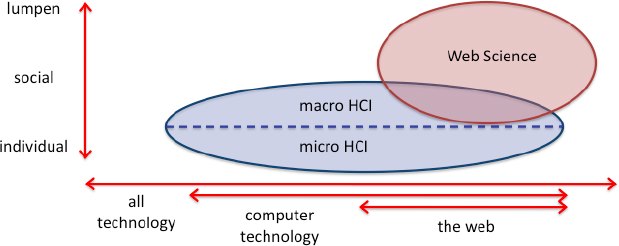
Fig. 7. Scope of HCI and Web Science – scale of human
phenomena vs. kind of technology
[zoom image]
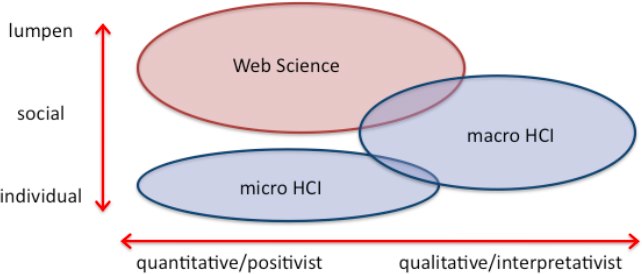
Fig. 8. Scope of HCI and Web Science – human scale vs.
methodological stance
[zoom image]